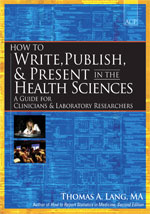Communication Services
|
On-Site training Topics
|
Tom's Books |

How to Report Statistics in Medicine: Annotated Guidelines for Authors Editors, and Reviewers, 2nd Edition
|
|
How to Report Statistics in Medicine, Second edition, presents a comprehensive—and comprehensible—set of guidelines for reporting the statistical analyses and research designs and activities commonly used in biomedical research.
Containing elements of a reference book, a style manual, a dictionary, an encyclopedia, and a textbook, it is now a standard guide in the fields of medical writing, scientific publications, and evidence-based medicine throughout the world.
Features:
- • Specific, detailed guidelines for reporting and interpreting statistics and research designs and activities in biomedical science.
- • Sample presentations that guide you in reporting statistics correctly and completely.
- • Coverage of current and emerging topics in statistics and trial design
Written by a senior medical writer and a senior biostatistician, the text is both clear and accurate, and the information is complete and pragmatic. Designed for anyone who needs to understand, interpret, or report statistics in medicine.

How to Write, Publish, and Present in the Health Sciences: Guidelines for Clinicians and Laboratory Researchers
How to Write, Publish, and Present in the Health Sciences provides advice and techniques for preparing formal scientific communications: abstracts, posters, slides, grant proposals, and scientific articles. It also addresses the related topics of writing effectively and efficiently; preparing tables, graphs, drawings, and photographs for publication; creating posters and slides; and documenting clinical and laboratory images for publication.
A profound, if unacknowledged, truth is that science could not exist without writing. Another truth, likewise unacknowledged, is that scientific writing is not just about writing. It is about communicating with graphs, tables, statistics, and images, as well as with words. It is about persuading readers with reason, fact, and logic to accept the research as credible. It is about documenting experimental protocols, analytical methods, and results so that the research can be evaluated, interpreted, and replicated. It is about archiving the research in the scientific literature so that others can find it, learn it, and build on it.
By addressing these other functions of scientific writing, How to Write, Publish, and Present in the Health Sciences goes well beyond the usual books in this field to create a uniquely valuable resource.
